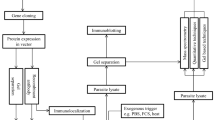Abstract
Ostertagiosis remains an economically important parasitic disease in cattle in the temperate regions of the world. Repeated exposures to Ostertagia ostertagi in calves cause significant pathology in the abomasum but elicit little protective immunity. The larvae use the host’s gastric glands as a niche for development, where the parasite completes its parasitic stages, while in the gastric glands, the larvae must down-regulate the host inflammatory immune responses. Annexin (ANX) A1, commonly found in most eukaryotes, is heavily involved in controlling anti-inflammatory responses by binding receptors on leukocytes. We hypothesized, therefore, that parasite proteins of the ANX family may be involved in host-parasite interactions during ostertagiosis. BLASTN search with the bovine ANXA1 identified two families of Oos-ANX like proteins (Oos-ANXL), each of which was highly conserved at the genetic level and identical at the amino acid sequence level. Oos-ANXL-1 is encoded by two transcripts and Oos-ANXL-2 by 20 transcripts. The present study characterized one Oos-ANXL, representing the most abundant Oos-ANXL, which was further defined as Oost-ANXL-2.1. Oos-ANXL-2.1 with a coding sequence of 519 bp was PCR-amplified, cloned, and expressed. Oos-ANXL-2.1 was immunolocalized to both L3 and adult, but not L4. The staining appeared to be associated with the gut and hypodermis in L3, but it was specifically localized to the hypodermis in adult worms. Western blots detected three protein bands in parasite lysates using anti-recombinant Oos-ANXL-2.1 antibody. Integrated optical density for each of the 3 Oos-ANXL-2s or the total Oos-ANXL-2s detected by Western blots (P < 0.05) was higher in adult worms than in L3 or L4. The results indicate that the production of Oos-ANXL-2s is developmentally regulated and most abundant in the adult worm. This rather large family of proteins could be a potential vaccine target against O. ostertagi infection and warrants further investigation.




Similar content being viewed by others
References
Ahluwalia A (1998) Topical glucocorticoids and the ski—mechanisms of action: an update. Mediat Inflamm 7:183–193
Braschi S, Borges WC, Wilson RA (2006) Proteomic analysis of the schistosome tegument and its surface membranes. Mem Inst Oswaldo Cruz 101(Suppl 1):205–212
Buckingham JC, Solito E, John C, Tierney T, Taylor A, Flower R, Christian H, Morris J (2003) Annexin 1: a paracrine/juxtacrine mediator of glucorticoid action in the neuroendocrine system. Cell Biochem Funct 21:217–221
Clark GB, Sessions A, Eastburn DJ, Roux SJ (2001) Differential expression of members of the annexin multigene family in Arabidopsis. Plant Physiol 126:1072–1084
Creutz CE (1992) The annexins and exocytosis. Science 258:924–931
Fox MT (1993) Pathophysiology of infection with Ostertagia ostertagi in cattle. Vet Parasitol 46:143–158
Fox MT (1997) Pathophysiology of infection with gastrointestinal nematodes in domestic ruminants: recent developments. Vet Parasitol 72:285–297
Gavins FN, Hickey MJ (2012) Annexin A1 and the regulation of innate and adaptive immunity. Front Immunol 3:354
Gerke V, Creutz CE, Moss SE (2005) Annexins: linking Ca2+ signalling to membrane dynamics. Nat Rev Mol Cell Biol 6:449–461
Gibbs HC (1988) The epidemiology of bovine ostertagiasis in the north temperate regions of North America. Vet Parasitol 27:39–47
Guo YJ, Sun SH, Zhang Y, Chen ZH, Wang KY, Huang L, Zhang S, Zhang HY, Wang QM, Wu D, Zhu WJ (2004) Protection of pigs against Taenia solium cysticercosis using recombinant antigen or in combination with DNA vaccine. Vaccine 22:3841–3847
Heizer E, Zarlenga DS, Rosa B, Gao X, Gasser RB, De GJ, Geldhof P, Mitreva M (2013) Transcriptome analyses reveal protein and domain families that delineate stage-related development in the economically important parasitic nematodes, Ostertagia ostertagi and Cooperia oncophora. BMC Genomics 14:118
Nishioka S, Aikawa J, Ida M, Matsumoto I, Street M, Tsujimoto M, Kojima-Aikawa K (2007) Ligand-binding activity and expression profile of annexins in Caenorhabditis elegans. J Biochem 141:47–55
Parente L, Solito E (2004) Annexin 1: more than an anti-phospholipase protein. Inflamm Res 53:125–132
Perretti M, Gavins FN (2003) Annexin 1: an endogenous anti-inflammatory protein. News Physiol Sci 18:60–64
Qu G, Fetterer R, Jenkins M, Leng L, Shen Z, Murphy C, Han W, Bucala R, Tuo W (2013) Characterization of Neospora caninum macrophage migration inhibitory factor. Exp Parasitol 135:246–256
Qu G, Fetterer R, Leng L, Du X, Zarlenga D, Shen Z, Han W, Bucala R, Tuo W (2014) Ostertagia ostertagi macrophage migration inhibitory factor is present in all developmental stages and may cross-regulate host functions through interaction with the host receptor. Int J Parasitol 44:355–367
Rescher U, Gerke V (2004) Annexins—unique membrane binding proteins with diverse functions. J Cell Sci 117:2631–2639
van Genderen HO, Kenis H, Hofstra L, Narula J, Reutelingsperger CP (2008) Extracellular annexin A5: functions of phosphatidylserine-binding and two-dimensional crystallization. Biochim Biophys Acta 1783:953–963
Weiland ME, Palm JE, Griffiths WJ, McCaffery JM, Svard SG (2003) Characterisation of alpha-1 giardin: an immunodominant Giardia lamblia annexin with glycosaminoglycan-binding activity. Int J Parasitol 33:1341–1351
Yan HL, Xue G, Mei Q, Ding FX, Wang YZ, Sun SH (2008) Calcium-dependent proapoptotic effect of Taenia solium metacestodes annexin B1 on human eosinophils: a novel strategy to prevent host immune response. Int J Biochem Cell Biol 40:2151–2163
Zhang Y, Wang KH, Guo YJ, Lu YM, Yan HL, Song YL, Wang F, Ding FX, Sun SH (2007) Annexin B1 from Taenia solium metacestodes is a newly characterized member of the annexin family. Biol Chem 388:601–610
Acknowledgements
Authors are grateful to Mr. Eliseo Miramontes, Ms. Marsha Campbell, Ms. Deborah Hebert, Dr. Celia O’Brien for excellent technical assistance. Research was supported by USDA/ARS intramural funds (WT and DZ).
Author information
Authors and Affiliations
Corresponding author
Rights and permissions
About this article
Cite this article
Sharma, P., Jenkins, M., Zarlenga, D. et al. Characterization of Ostertagia ostertagi annexin-like proteins at different developmental stages. Parasitol Res 116, 1515–1522 (2017). https://doi.org/10.1007/s00436-017-5428-8
Received:
Accepted:
Published:
Issue Date:
DOI: https://doi.org/10.1007/s00436-017-5428-8




